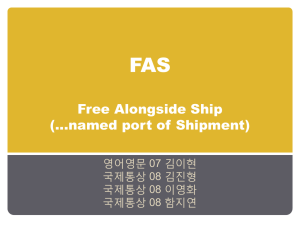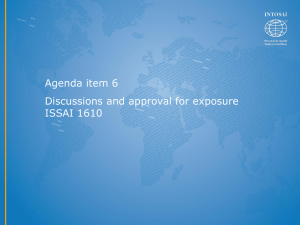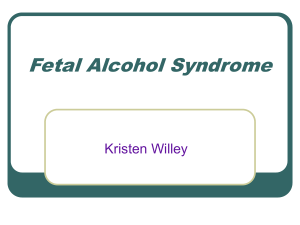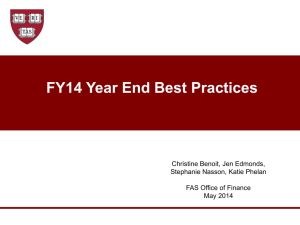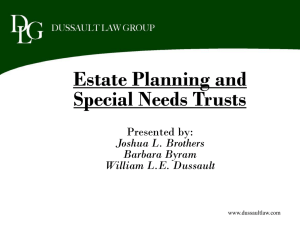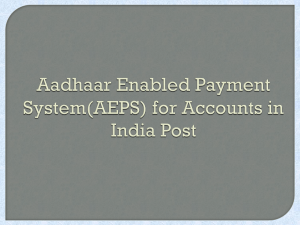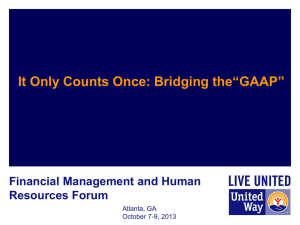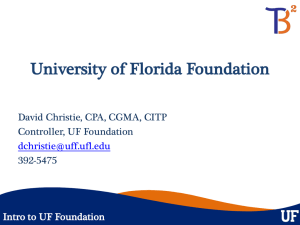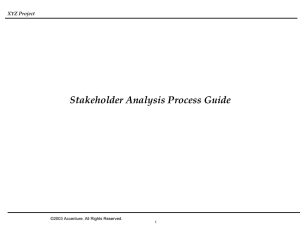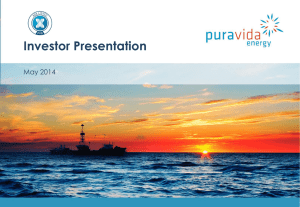VIEs - Saint Louis University
advertisement
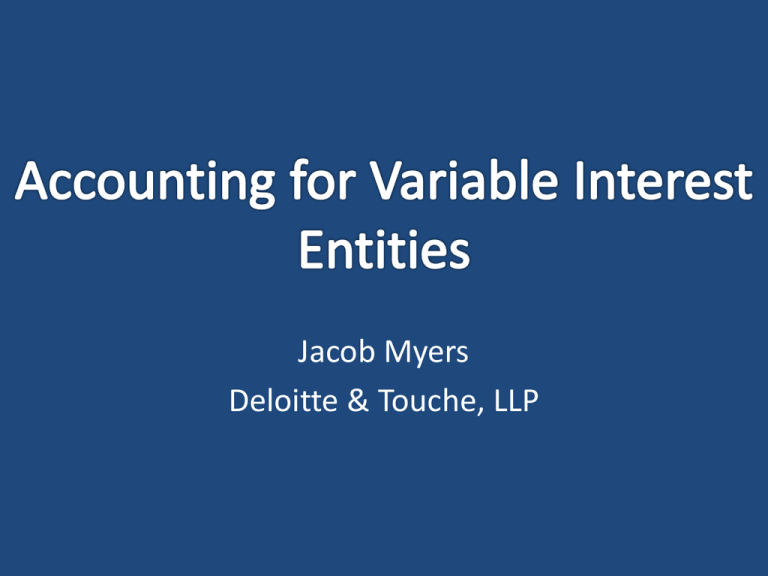
Jacob Myers Deloitte & Touche, LLP Agenda • Introduction • Background - FIN 46(R), FAS 140, FAS 167 • Comparisons to newly issued FAS 167 guidance • Research tools • Case study • Audit issues • Questions & Comments Introduction • Jacob Myers – Deloitte Senior Manager – Assurance Services – Service clients in various industries • Financial Services, Software, Agriculture – St. Louis University • Majors - Accounting and Finance – Other organizations • St. Louis Variety Club – Finance Committee • St. Louis University Business School Alumni Board Why Consolidation Guidance • Add transparency and consistency to the financial statements – Many firms were avoiding reporting debt and losses from special purpose entity (SPE) deals • Enron • Recent credit crisis • Impact of consolidation in marketplace – – – – Financial ratios Loan covenants Regulatory capital Cost to implement guidance, processes FIN 46(R) • Variable Interest Entities – VIEs • Special Purpose Entities – SPEs, off balance sheet – Form & Purpose of VIEs • Trust, Partnership, joint ventures, or Corporation • Facilitate transactions – Transfer of Assets, leasing, hedging, R&D • Low-cost financing structure – Characteristics of VIEs • Activities are limited • Equity investor role minor – less than 10% • Sponsoring firm’s involvement – Guarantees – Contribution of Capital – Risks and rewards FIN46(R) • Consolidation of VIEs – Prior GAAP - ARB 51 • Consolidated based on voting rights – Identifying if a VIE exists • Equity at risk not sufficient to permit the potential VIE to finance its activities • Equity investors lack one of the following: – Direct or indirect ability to make decisions about entity through voting or similar rights – An obligation to absorb the expected losses of the entity – Rights to receive the expected residual returns of the entity FIN46(R) – Identification of the Primary Beneficiary of the VIE • Requires the primary beneficiary to consolidate • Characteristics include (mirror equity investors in a VIE): – The direct or indirect ability to make decisions about the VIEs activities – The obligation to absorb the entity’s expected losses – The right to receive the entity’s expected residual returns • Assessment of control – Entity that bears the majority of the risk FIN46(R) – Disclosure Requirements • For Primary Beneficiaries – VIE’s nature, purpose, size and activities – Carrying amount and classification of consolidated assets – Lack of Recourse (if any) • Significant Variable Interest (Not Primary Beneficiary) – Nature of involvement with VIE – Nature, purpose and size of VIE – Exposure to losses FAS 140 • Transfers of financial assets – Mortgage loans, accounts receivable, credit card receivables • Qualifying Special-Purpose Entities - QSPE’s – Indicated that financial assets transferred to a QSPE are typically derecognized by the transferor – Legal isolation concept • Permits derecognition of a portion or a component of a financial asset • Relates to FIN 46(R) because QSPE’s are exempt from consolidation requirements Potential Primary Beneficiary Potential VIEs Guarantees Debt Max Return 6% 95% Debt owed by Leases Data Center JP Morgan ABC Data Center, LLC 5% Equity Microsoft Unrelated Shareholders & Debt holders Facebook Investment of 1% Outstanding 70% Equity Shares of Intel 30% Debt Leases Office Space 95% of Debt owed by Goldman Sachs XYZ Office Leasing 5% Equity Non Voting Metlife FAS 167 • Recently issued guidance for consolidations • Why FAS 167 – Needed to expand disclosure requirements of FIN 46R and address elimination of QSPEs • Broader Scope: – Includes Entities covered under FIN46R and QSPE’s • FAS 166 eliminated the concept of a QSPE – Amends derecognition guidance in FAS 140 – Expands the Consolidation and Disclosure Requirements associated with VIE’s Comparison FIN 46(R) FAS 167 1. QSPE’s are generally exempt 1. Transferors, sponsors, and 2. Primary BeneficiaryQuantitative Reasoning: 2. Primary BeneficiaryQualitative Reasoning: – Based on Risks and Rewards 3. Shared Power: – Focus is on absorbing expected losses or receiving expected returns investors in QSPE’s need to consider consolidation and disclosure – Power and economics model – Power to direct activities – Obligation to absorb losses 3. Shared Power: – Power to direct activities – Do decisions require the consent of both parties Comparison FIN 46(R) 4. Reconsideration of Primary Beneficiary: – – Changes in contractual agreement Addition or disposal of interest 5. Reconsideration of VIE: – Interest holders reconsider whether entity is a VIE if certain events occur FAS 167 4. Reconsideration of Primary Beneficiary – Continuous reconsideration 5. Reconsideration of VIE: – An additional event requires reconsideration Comparison FIN 46(R) FAS 167 6. Presentation Requirements: 6. Presentation Requirements: – Not required to present consolidated VIE separately on Balance Sheet – Must present separately on the face of Balance Sheet the: • Assets used to settle obligations • Liabilities for which creditors do not have recourse against primary beneficiary FAS 167 Disclosure Requirements • Financial preparers must disclose method for determining whether they are the primary beneficiary of a VIE – Disclose significant judgments and assumptions made • Must disclose the details of any financial or other support provided to a VIE – Disclose reasons for providing the support – Disclose all terms of arrangements and agreements with VIE • If Shared Power between multiple parties – Disclose Significant Factors and Judgments made in determination Research Tools • Orginal FASB pronouncements • Third party service providers – Lawyers, accountants, etc. • Online research tools • Other company disclosures • Other publications – AICPA, SEC, public accounting firms, state societies Case Study XYZ Oil is an established oil drilling company that wants to expand its operations to offshore drilling platforms in the Gulf of Mexico. XYZ determines that it can obtain the $350 million needed to lease the platform by issuing debt at an annual interest rate of 5%. Instead of leasing the platform itself, XYZ decides to establish a separate legal entity, Saltwater Drilling Co., to lease the drilling platform. In doing so it can obtain the $350 million needed at an annual rate of 4%. An outside investor contributes $30 million for 100% of the nonvoting shares in Saltwater Drilling Co. The remaining $320 million is raised through a debt offering, of which XYZ is the guarantor. XYZ must also pay the investor for any losses incurred if the asset is sold at the end of the lease term. Questions • Would Saltwater Drilling Co. qualify as a VIE under FIN 46? Under FAS 167? – Could Saltwater Drilling have obtained financing without XYZ guaranteeing the debt? – Does the equity investor have the ability to make decisions about the entities’ activities? – Does the equity investor bear the risk of loss? – Does the equity investor receive the expected residual returns? • Would XYZ qualify as a primary beneficiary? – Does XYZ have the power to direct the activities of Saltwater? – Does it bear the risk of loss or have the right to receive benefits? – Would it qualify as a primary beneficiary under FIN 46? FAS 167? Questions • What documents would you need to examine to determine that Saltwater is a VIE with XYZ as its primary beneficiary? • Should Saltwater be consolidated into XYZ? – How should this be presented on the Financial Statements? Answers • Would Saltwater Drilling Co. qualify as a VIE under FIN 46(R)? Under FAS 167? – The answer is probably ‘Yes’ under both. The equity investor has an insignificant (less than 10% ownership) and the entity probably couldn’t finance the operations without XYZ’s support. – The investor also bears little risk as they are guaranteed their money back if the asset is sold at a loss at the end of the lease. • Would XYZ Qualify as a Primary Beneficiary? – Probably ‘Yes’ under both FIN 46(R) and FAS 167 – The investor doesn’t appear to bear much risk and since they own non-voting stock their influence may not be significant. – XYZ appears to bear the risk of loss since they are guaranteeing the debt. – Examination of the agreements would be needed to see who has the power to direct activities and the obligation to absorb losses and receive benefits. Answers • So, should Saltwater Drilling Co. be consolidated into XYZ? – If it is determined that Saltwater Drilling Co. is both a VIE and XYZ Oil is its primary beneficiary then it should be consolidated into the Financial Statements – Under FAS 167, certain assets and liabilities would be required to be presented separately on the face of the financial statements and additional disclosures would be required Audit Issues • Audit evidence – Company’s accounting memo – Entity documents • By laws • Security holder agreements • Legal Opinions • Consideration of an effective control environment – Timing of closing process for the SPE • Use of specialist/expert • International coordination – Language barriers and translation issues – Legal environment Questions or Comments? jacmyers@deloitte.com
